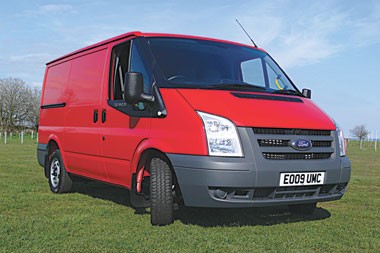Review
We’ve been champing at the bit for a few weeks now waiting for our new long-term Ford Transit to arrive – and now it’s here, it was well worth the wait.
Our Transit is a very special vehicle indeed, being built exclusively for us by Ford and featuring the exact specifications we asked for.
Unfortunately, the boat which brought it to England from its birthplace in Turkey encountered a huge storm on the way and several vehicles, including ours, were damaged – hence the wait while a new roof was put on.
But now it has arrived at Fleet Towers, you have only to look at the picture to see what a dazzling van it is, clad in bright pillar box red and looking every bit a winner.
Our new van is the smallest Transit you can buy, weighing in at 2.6 tonnes gross vehicle weight. Ford has pulled off a neat trick where Transit is concerned.
Most of the other manufacturers offer two different panel vans (Vauxhall Vivaro/Movano, Volkswagen Transporter/Crafter etc), but Ford simply builds a huge array of Transits that cross the weight lines of the others. In fact, 7,200 variants of Transit are available.
There’s a reason why we chose the smallest Transit – it won the Fleet News light panel van of the year award last year.
I was a member of the judging panel and I well remember the judges all agreeing that this was the pick of the Ford panel van crop.
We also opted for the 115bhp powerplant as we reckon it’s about the right amount of punch for a panel van.
It won’t be struggling on the hills when loaded but it’s not so powerful that your drivers will be tempted to act the boy racer, thus increasing both your fuel bills and your insurance costs when they crash into things.
As for the rest of the goodies we ordered, there was a staggering choice. Anyone who has visited America will know what a faff it is ordering breakfast.
There are three million different combinations, four million different ways to have your eggs cooked and five million different kinds of toast.
Well, that’s just what it’s like ordering a panel van nowadays and it’s a minefield for the fleet operator to know just what to choose.
After all, you don’t want to waste money but then again there are so many health and safety regulations around that you could find yourself in trouble with the law for skimping.
Being a Transit, ABS brakes and ESP traction control are fitted as standard, which is a massive slap on the back for Ford in our book as we’re all keen on matters of safety.
Apart from the Volkswagen Transporter/Crafter and Mercedes-Benz Vito/Sprinter, all the other manufacturers charge for traction control, a travesty in the Fleet Van book.
But what about all those other items such as air conditioning? It’s not cheap but just think – a cool driver is a safer driver, so maybe these days it’s more of a must than a nice extra to have.
In the end we decided not to bother – after all, when was the last time we had a hot day in this country?
One box certainly ticked was the passenger airbag.
I’ll be ferrying the Mem Sahib about quite a bit during our six-month test period and she’s worth more than the price of an airbag to me.
We also opted for the Quickclear windscreen which comes as part of a visibility package including electric heated door mirrors at £175.
Most vans, including this one, are kept outside and it’s a miracle to see this item in operation on cold mornings.
Ford also added a built-in sat-nav unit that we hadn’t actually asked for. It’s a £945 option and personally if I was going to buy sat-nav for my drivers I would get those cheapie units from Halfords.
The total cost of this vehicle thus rose to £17,930 (all prices ex-VAT).
On the day of the Transit’s arrival, I spent a happy half-hour poking around in the cabin and it is clear that a great deal of thought has gone into making it a friendly place in which
to work.
There’s a 12-volt take-off on the top of the dash on the driver’s side, for example, which is presumably made for recharging a mobile phone.
A flap in the middle of the dash folds over to reveal a little desk with two cupholders and there are cubby holes and spaces in every conceivable nook and cranny – ample for holding white van man’s tons of detritus.
Meanwhile, the rear cargo area features half-height lining, which should stop items damaging the rear end from the inside.
There’s a flat wipe-clean floor too.
We’ve only put a few miles on the clock so far, so we can’t yet reveal anything about fuel economy, but we’ll be reporting again soon on how our new recruit is shaping up.
















